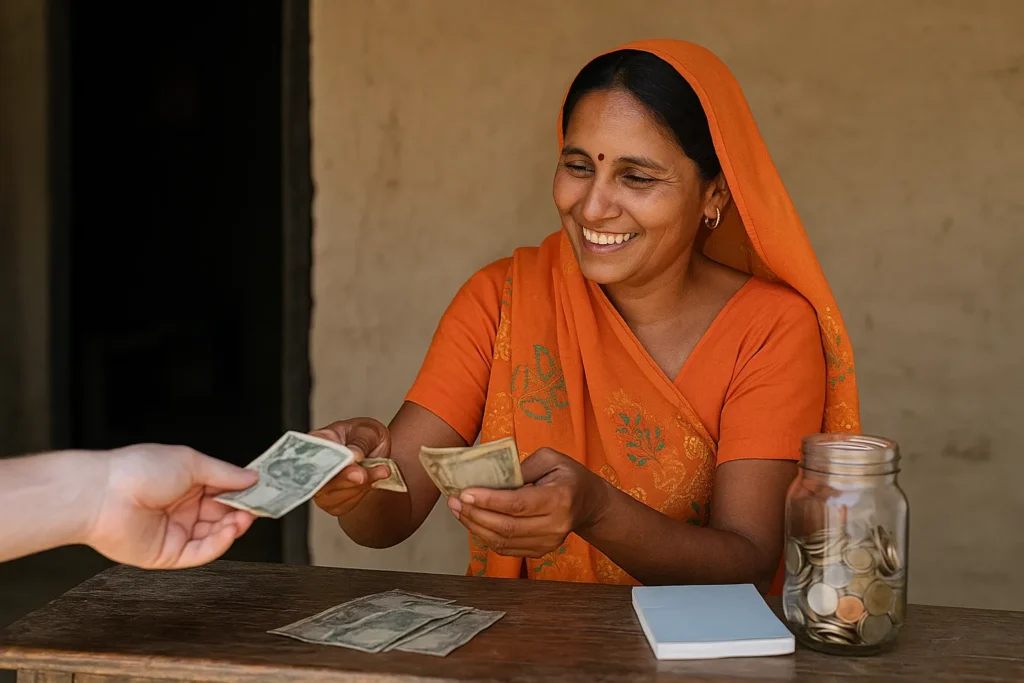For millions around the world, starting a business or handling a financial emergency is out of reach, due to a lack of access. Traditional banks require formal jobs, credit histories, and collateral that many informal workers, especially in rural areas, don’t have.
Yet behind these barriers are individuals with the ideas, drive, and determination to build better futures.
Microfinance offers a different path. By providing small loans as low as $50 or $100, it can help people launch businesses, support families, and create financial stability. These are practical tools for people who are already working hard to improve their lives.
In the sections ahead, we’ll cover the impact of microfinance, examine the challenges that come with it, and introduce the social finance solutions that are helping this model grow stronger and smarter. Let’s begin by looking at why microfinance matters in the first place.
How Microfinance Changes Lives
Microfinance can be used for everything from covering household expenses to starting micro-enterprises. But the real power of microfinance lies in what people do with it. These small loans fuel progress in everyday life. They help individuals meet needs, take risks, and build futures.

Here’s how microfinance makes a difference:
- Entrepreneurship thrives: People can start or grow micro-businesses with small loans. In Bangladesh, Rehana Begum started with just one sewing machine and a dream. Through microloans, she gradually expanded it to 35 machines. Now her company is worth nearly $30 million!
- Education becomes accessible: Microloans help families cover school fees, uniforms, and supplies. This helps children stay in school and improves their long-term prospects.
- Women gain independence: Many microfinance clients are women. Financial access strengthens their role in the household, builds confidence, and increases leadership within the community.
- Local economies grow: Small businesses invest back into their communities. A farmer’s loan helps pay for tools, feed, and part-time labor, boosting economic activity.
- Social cohesion strengthens: Peer lending groups encourage mutual accountability. These networks promote trust and shared responsibility, which makes communities stronger.
From the outside, these changes might seem small. But to those living them, they are monumental. Let’s now look at the other side of microfinance.
The Other Side of Microfinance
Microfinance is often praised for the way it lifts people out of poverty, but it’s important to recognise that it does not always work as intended. For some borrowers, a loan adds pressure instead of relief.
When income is unpredictable, weekly repayments can become a source of stress. A failed crop, a slow month at the market or an unexpected illness can make it hard to keep up. Some borrowers fall behind. Others borrow from new lenders just to repay the first loan, creating a cycle of debt that is hard to escape.
Group lending can also create unintended pressure. If one member struggles, others in the group may be forced to cover their repayment. This can strain relationships and cause tension in communities that rely on trust.
But there’s one more challenge that’s even more of a concern: interest rates. Even if rates are lower than informal lenders, they can still be high enough to cause hardship. Many borrowers do not fully understand the terms until they are already in debt.
Technology is helping improve access and reduce costs. However, it also introduces challenges. Not all borrowers have smartphones, digital literacy or stable internet.
For microfinance to remain effective, it must be built around flexibility, education and support and not just the loan itself. This need for thoughtful, people-first design reflects a broader transformation happening across the financial world that we’ll unpack in the next section.
The New Face of Finance: Purpose, People, and Impact
Microfinance is just one part of a growing shift in how we think about money. Financial systems worldwide are changing to balance profit with the well-being of people and the positive impact on society. This shift focuses on financial inclusion, sustainability, and transparency, promoting long-term benefits and ethical practices.

Here are some of the key ideas shaping this new approach:
- Social impact bonds: Social finance is a $715 billion global market. Investors fund social programs upfront and are repaid by the government only if the programs deliver results. This ties funding to real-world outcomes rather than assumptions.
- Green lending: These loans support eco-friendly projects like solar energy, water access or sustainable farming tools. They help low-income communities grow while protecting natural resources.
- Community finance initiatives: Local financial institutions provide loans for housing, education and small business in underserved areas. They focus on strengthening long-term community wellbeing.
- Blended finance: Blended finance mobilised over USD $231 billion globally between 2014 and 2024. It combines private investment with government or donor funding to reduce risk in projects that deliver social or environmental benefits. This makes high-impact work more investable.
- Measuring what matters: Traditional finance tracks returns, but social finance tracks impact. Tools like Social Return on Investment (SROI) help gauge real benefits to people and communities.
Microfinance fits naturally into this space. It shares the goal of giving people tools to lift themselves out of poverty and contribute to stronger, more inclusive economies.
But to reach more people, in more places, with greater efficiency, microfinance must evolve. That is what we’ll discuss in the next section.
The Future of Microfinance Is in Your Pocket
How do you bring banking to someone who has never stepped inside a bank? Mobile phones, digital wallets and smart data tools are transforming microfinance, bringing speed, flexibility and access to places traditional banking never reached. For many borrowers, their first experience with finance is now happening on a screen.
Here’s how it’s happening:
Mobile Applications
Over 1.6 billion people globally registered mobile money accounts. Microfinance borrowers can now apply for loans, check balances and schedule repayments using simple mobile apps. These tools reduce travel time, eliminate paperwork and provide 24/7 access to essential services.
SMS Reminders
In areas without smartphones or strong internet, text messages help borrowers stay on track. Alerts for upcoming payments and account activity reduce missed deadlines and improve repayment rates.
Digital Wallets and Mobile Transfers
Users can store money, make transactions or receive loan disbursements instantly. This is especially useful in rural communities, where physical banks or cash handlers may be far away.
Blockchain for Record-Keeping
Some MFIs are using blockchain technology to ensure secure, tamper-proof loan histories. This helps build borrower trust and reduces the risk of data manipulation or administrative errors.
AI-Based Lending Models
Artificial intelligence analyses transaction patterns, mobile usage and alternative data to assess credit risk, giving people without formal credit histories a chance at fair financing.
Remote Learning and Digital Support
Borrowers can now access financial education modules, repayment tips and customer service through online platforms, reducing dependency on in-person training.
Hybrid Models of Delivery
Many institutions now mix digital tools with local agents who offer face-to-face support. This approach keeps microfinance human while scaling its reach.
Technology isn’t a standalone solution. Many borrowers still face limited internet access, low digital literacy and mistrust of online platforms. Without support and education, digital tools can fall short.
The COVID-19 pandemic accelerated this shift. As in-person services paused, lenders turned to digital solutions faster than expected. This change sparked innovation but also exposed deep gaps in access and readiness.
As smartphones become more common and tools more affordable, the future of microfinance is increasingly personal, portable and powered by data. But the heart of it remains the same: giving people a fair chance.
What You Can Do Next
You do not need to be a banker or policymaker to make a difference. Microfinance works because ordinary people believe in small, steady change and choose to support it.
If the microfinance impact speaks to you, there are a few simple ways to get involved. You can support reputable microfinance institutions by donating, lending or investing through trusted platforms. Even a small amount can help someone take their first step toward independence.
You can also bring the conversation into your workplace. Many businesses are exploring social finance solutions that align investments with positive outcomes. Ask how your organisation handles social impact. Share what you have learned.
Most importantly, keep listening to the stories behind the statistics. Change starts with understanding. The more we recognise the potential in people, the stronger and more inclusive our financial systems will become.
Microfinance isn’t going to save the world overnight, but it contributes to something that makes a difference, one step at a time.


